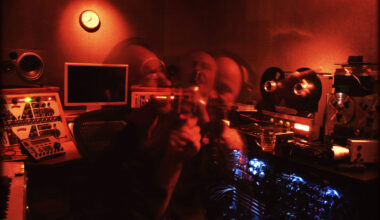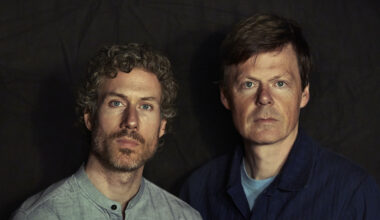Maybe he was in Virgin Prunes and the lynchpin of the Princess Tinymeat offshoot, or maybe he wasn’t. Discover how the enigmatic Daniel Figgis is still crafting beguiling music and bewildering audiences today, thank goodness
“He’s two people and he’s had three careers,” laughs Daniel Figgis down the phone, almost as though the thought has only just occurred to him. Reviewing his creative output that spans almost 50 years (he started out very early, as we’ll discover) is never going to be an easy job. But in the case of this Irish musician, producer and composer, things can get very complicated.
Take, for instance, the reason for our interview, the current CD release ‘A Map Of The Kingdom Of Ireland’. It appears, on first view, to be a compilation of contemporary electro acoustic, post-classical and experimental electronic artists. But closer inspection reveals the Figgis name cropping up again and again, alongside the likes of Microdisney/The Fatima Mansions singer Cathal Coughlan, Dik Evans (brother of U2’s The Edge and long-time Figgis collaborator) and Daniel’s eight-year-old son Charles. While Daniel plays on a roughly a third of the sometimes complex but always sublime compilation, which sees gorgeously textured acoustic recordings spliced up and rearranged using modern day processing and editing techniques, he’s the central point of reference that the others revolve around. Everyone included here has worked with him in one shape or another.
Those with longer memories – or a keener eye on musical history – might also note the appearance of ‘Your Majesty’ and ‘MegaMix’, two tracks by the band Princess Tinymeat. The band, who supposedly took their name from a particularly unflattering nickname for 1940s heartthrob actor Montgomery Clift, were one of two factions that the post-punk band Virgin Prunes split into. History tells us that Figgis, of course, was a member of both Virgin Prunes and Princess Tinymeat, although if you ask him about it he’ll only go as far as admitting some vague knowledge of a character called Binttii, his stage name at the time.
“I haven’t encountered Binttii’s caterwauling since the mid-80s,” says Daniel mischievously, “nor his drumming, keyboard playing, and germinal tape work.” He believes Binttii was fired from Virgin Prunes because of disagreements over writing credits, but “having said that, he had apparently already nailed a solo deal while still a member of the band, which cannot have gone down well with the others.”
Equally as telling as the inclusion of the Princess Tinymeat tracks on ‘A Map…’ is the fact that while Daniel confides he has had to work hard to escape this initial legacy, developing as a solo artist with the revolutionary mid-90s album ‘Skipper’ on Rough Trade and then working as a composer and installation artist, he defends the pioneering work that Princess Tinymeat did. He certainly speaks proudly of the moment when PTM were rehearsing in a Dublin studio and word reached them that their anarchic output was eliciting complaints from another of the studio’s inhabitants – one “Fast” Eddie Clarke of Motörhead fame. Their use of electronics, industrial and post-punk attitude and controversial imagery, with the openly transvestite Figgis often its provocative focal point, was undeniably way ahead of the game.
When he’s asked about the parallels drawn by others between Princess Tinymeat and the much later My Bloody Valentine – particularly the use of noise and “elfin” vocals – he initially says “you’d have to ask Kevin Shields”, but then adds fairly definitively that “chronology trumps speculation in this case.”
Likewise, PTM’s use of distressed vinyl and surface crackle in their work is also something Figgis feels they haven’t received full credit for. “PTM were the first that I heard using that Fine Arts application in audio. By the time trip hop came along you couldn’t move for the crackles. But initially records were returned en masse.”
The roots of such experiments go right back to Daniel’s childhood. He’s from Ranelagh, outside Dublin, which he describes as being “almost a hamlet that one aspired to escape in the 1960s and 1970s” and somewhere that, although he did manage to escape, he now returns to often because his son attends school there.
After constructing compositions on his grandmother’s piano, one of which later made the ‘Skipper’ album (‘Egg & Anchor’), the next stage was the tape recorder. “Give a child a tape recorder and he’ll most likely discover scissors and Sellotape soon after,” he states. Vivaldi was the first “victim” of his edits and synthetic layering, but another experiment, undertaken at the age of 14 or 15, particularly lingers in his memory,.
“My aunt and uncle were having an interminable argument in grandmother’s living room, 15 minutes in I decided to record the row, and 15 minutes further in, replay the earlier iterations of the row in the background which, while they gathered their thoughts, plugged the gaps in the bickering.”

He grew up listening to a broad church of music, becoming passionate about The Beatles (”although ‘Help!’ almost scared me to death”) and The Rolling Stones, Vivaldi and Holst, Rod McKuen, Barbra Streisand, the ‘Black Beauty’ theme and ‘Greensleeves’, as well as musicals like ‘West Side Story’, ‘Oliver!’ and especially ‘Mary Poppins’ (”Particularly ‘Feed The Birds’,” he says, “although in recent years, ‘Let’s Go Fly A Kite’ is the one that always reduces me to tears”).
He was a child actor for more than a decade, between the ages of five and 16, most notably appearing alongside Peter O’Toole as The Boy in Samuel Beckett’s ‘Waiting For Godot’ at Dublin’s Abbey Theatre and the Nottingham Playhouse, as well as a number of roles on TV and film.
“Acting’s not really a team exercise,” says Daniel when asked what acting has brought to his later work.
“You’re always striving to find your light, hit the mark. So I’ve struggled with traditional band dynamics, and tend to work with large numbers of people strictly on a one-on-one basis, but as a solo artist.”
His transformation into that solo artist became complete with the release of ‘Skipper’, an album of meditational, near-ambient instrumentals that reflected his love of folk music such as John Martyn and the Canterbury scene, but also the transporting qualities of post-classical music. He dismisses the term “electronica”, even though some might call it that, mainly because he works almost exclusively with acoustic rather electronic instruments, using studio technology to process and rearrange them.
He has even less time for the lo-fi tag, which is probably more to do with its bedsit origins than the lush, expansive end results. “I’ve never made anything lo-fi in my life,” he insists with clear derision.
This era marked a change his lifestyle, too, with his clubbing days mostly behind him, and a new love entering his life, not to mention the ingestion of certain unnamed mellowing substances. While it may have seemed a drastic transition to some, ‘Skipper’ was in fact a long-term project that eventually came to fruition in 1995, with three tracks written as far back as the mid-1970s.
“I had resettled ‘in nature’ as a destination and inspiration,” he recalls, looking back, “I reclaimed and aspired to melody and most especially harmony as the engines, working almost exclusively with acoustic instruments. My purchase of a relatively ancient harmonium spurred me on – that and a Casio sampling keyboard over which I had no control other than my internal censor.”
What Daniel defines as “my bedsit album, in the Scott Walker sense” has led, bit by bit, to the Daniel Figgis of today, a composer as well as producer/musician, with a hugely varied selection of achievements to his name, spanning everything from an “opera for dancers” called ‘The Banquet’, performed at Dublin’s National Basketball Arena, to work written in situ as a composer in residence of the city’s two great parks, St Enda’s and Marlay Park.
Rather than actively defying convention, he seems more blissfully unaware of it, always looking at more interesting and challenging ways to do things. When we suggest that the boundaries between various artistic disciplines seem to be falling away, he says: “I’m not, nor have ever been, concerned with boundaries of any kind. As a transvestite and, arguably a performance artist, I stepped outside of the normative at 18 years of age, which is roughly when I embarked upon a musical career.”
As an example, rather than creating a run-of-the-mill remix album with 2003’s ‘When It’s Ajar: The Music of Daniel Figgis?’, he opted instead for an album of re-composition, with the artists working solely with excerpts from his recordings and “re-imagining them in their own voice”.
He eventually extended his work as a composer into art installations and multi-disciplinary performances. His website danielfiggis.com has details of his numerous and often spectacular events, everything from appearing in the middle of a waterfall in the middle of a Dublin park, performing while suspended 100 feet above his audience, to an artwork which involved spectacularly illuminating a forest, but without inviting an audience to witness it, an extension of the philosophical concept of a falling tree making a sound if no one is around to hear it.
Following in this vein, his most high profile and innovative project of recent times was 2013’s ‘City Hall’, a show at Dublin’s City Hall where the audience actually created the composition. Having developed a fascination with the building’s Rotunda, a space which he senses many artists fight rather than embrace, he used infrared technology to let the audience trigger pre-prepared musical parts as they moved around the space over three days.
“I provide the alphabet, you write the sentence,” he says of the idea, which he hopes to stage in other building and even, in future, linking up different buildings in different cities across the world as an artistic contribution or gesture towards world peace. “Truly a music for the people by the people.”
Most recently, however, Figgis has been locked away Studio A1/2 in Dublin in the final, “painful”, mixing stages of a new solo album, 24 years in the making and including collaborations with a lengthy list of musicians. He persuaded one of his musical heroes, John Martyn, to play guitar on it.
“I think he was rather taken aback essentially being asked to be a session guy,” admits Figgis, relating the tale of meeting the legend in a remote pub in southern Ireland. On arrival, Martyn had become paranoid that Figgis was in fact a tax inspector and refused to leave his car until his girlfriend persuaded him that Daniel really didn’t look the type.
Recorded in Dublin, Cardiff, Tallinn, New York and Berlin and featuring field recordings from across the globe, the record features a grand cast list including Dieter Moebius, jazz pioneer Keith Tippett, Mark Stewart , David Jackson of Van Der Graaf Generator, Cathal Coughlan and performance artist and ‘Nathan Barley’ actor David Hoyle.
With negotiations advancing about an American release of ‘A Map…’, which would see the collection and also ‘Skipper’ being released on vinyl for the first time, we may also see Figgis returning to the live arena for the first time in a decade. There are two other recordings in the pipeline after that, the already completed ‘The Silence’ and ‘Dimmerswitch Variations’, about natural decay, largely recorded but unmixed.
As a sufferer of OCD, something which he says can focus the mind, but usually provides more downsides than ups when it comes to creative endeavours, it’s perhaps no wonder he finds these final mixing stages to be painful at times. He recalls a story about fellow Irishman and OCD sufferer James Joyce proudly directing guests to view a painting of Cork he owned which was surrounded by a cork frame.
“He would point at it and say, ‘That’s cork’. Having OCD is a bit like that,” he confides.
But just as nature has inspired many of his works, it also continues to provide solace and refuge from the creative maelstrom for Daniel.
“I find a long walk in the woods is conducive to getting the picture right,” he says. With several decades of rich and varied creativity under his belt and his productivity hitting new peaks, he’s clearly doing something right. Long may he continue to see the wood from the trees.
‘A Map Of The Kingdom Of Ireland’ is out on Heresy






